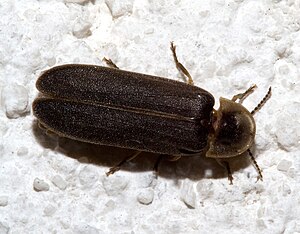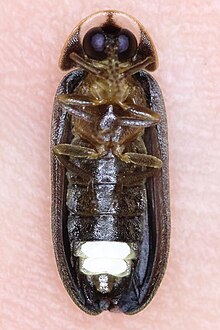Little firefly
| Little firefly | ||||||||||||
|---|---|---|---|---|---|---|---|---|---|---|---|---|

Little firefly ( Lamprohiza splendidula ), male |
||||||||||||
| Systematics | ||||||||||||
|
||||||||||||
| Scientific name | ||||||||||||
| Lamprohiza splendidula | ||||||||||||
| Linnaeus , 1767 |
The little firefly , the firefly or locust worm ( Lamprohiza splendidula ) is a species of beetle of the firefly family (Lampyridae).
description
The beetles are 8 to 10 millimeters (males) or 10 millimeters (females) long. On the pronotum that towers over the head, they have two large, transparent window spots through which the dark complex eyes shine. The males are similar to the great firefly ( Lampyris noctiluca ), but the pronotum has no window spots. Males and females of Lamprohiza splendidula can be easily distinguished from one another: the female has only extremely short wing stubs, so that the abdomen segmentation is visible and therefore looks like a larva . The body of the females is cream colored and translucent so that some organs can be seen through. This transparency of the body enables the light to shine through from the underside of the body, where the luminous organs are located. The light of the flightless females living on the ground can attract the males in the evening. The German name glow worms goes back to the larva-like shape and the luminosity of the females. The males have fully developed and functional wings. Her body is strongly flattened laterally, pronotum and forewings are gray-black. They stick out on the sides of the body and cover the legs during the day. In contrast to the females, the males only have two luminous organs on the belly side of the abdomen, which stand out due to their cream-colored color. The males of the little firefly are the only nocturnal animals in Germany that can fly and glow. Eggs, larvae and pupae also have luminous organs.
habitat
Fireflies are found in temperate Europe . Its northern limit of distribution is reached in Central Europe in Schleswig-Holstein. You can find fireflies in meadows, gardens and parks. When the beetles swarm, on warm summer nights in June and July, you can still see them frequently in some areas. During the public search in Saxony, Where does the glow-worm dance? from 2007 to 2009 several thousand males were counted in a single evening in some riparian forests. Riparian forests were recognized as the ideal habitat for this firefly. Outside of damp deciduous forests, fireflies occur regularly but in small numbers.
Way of life
According to Schwalb (1961), the little firefly has a three-year life cycle.
The larvae hatch about 35 days after oviposition. 34 months later they pupate and after a resting phase of 7 days the beetles hatch. The lifespan of the males is 5 to 7 days, that of the females 7 to 10 days.
The adult animals (= beetles) fly from mid-May to the end of July, but mostly in the third decade of June. The frequent occurrence around St. John's Day gave this type of beetle the German nickname Johanniswürmchen.
The males begin to fly and glow at dusk. Their ventral luminous organs send the light downwards and thus stimulate the females to shine in turn. If a male has discovered a female in this way, it flies down vertically to the female. Mating and oviposition take place on the ground. Both partners die just a few days after mating and laying eggs.
The larvae eat snails (small slugs and shell snails ), whose slime trail is followed. Adult animals (i.e. beetles) do not consume food, but do consume water. They live on the fat reserves that they have created during the three-year larval development.
Picture gallery
literature
- Schwalb, HH 1961: Contributions to the biology of the native lampyrids Lampyris noctiluca GEOFFR. and Phausis splendidula LEC. and experimental analysis of their prey catch and sexual behavior. Zoological yearbooks: Department for Systematics 88 (4): 399–550.
- Reicholf-Riehm, Helgard: Insects; 1984, Munich
Web links
- Species profile
- Saxon search operation "Where does the glowworm dance?" from 2007-2009
- University of Jena
- Firefly Project, Zurich
- Starting point - Fireflies in Germany
Individual evidence
- ↑ Nuss, M. & J. Seidel 2008: Historical occurrences of the glow worm ( Lamprohiza splendidula (Linnaeus, 1767)) in Saxony (Coleoptera: Lampyridae). - Saxon Entomological Journal 3: 30-38.
- ↑ Münch, M., M. Nuß & J. Seidel 2010: The glowworm ( Lamprohiza splendidula (Linnaeus, 1767)) in Saxony - summary of the results of the Saxon search campaign "Where does the glowworm dance?" From 2007–2009 (Coleoptera : Lampyridae). - Saxon Entomological Journal 5: 40-48.
- ^ Fireflies (Lamprohiza splendidula (Linnaeus, 1767)) . insekten-sachsen.de. Retrieved June 12, 2019.









